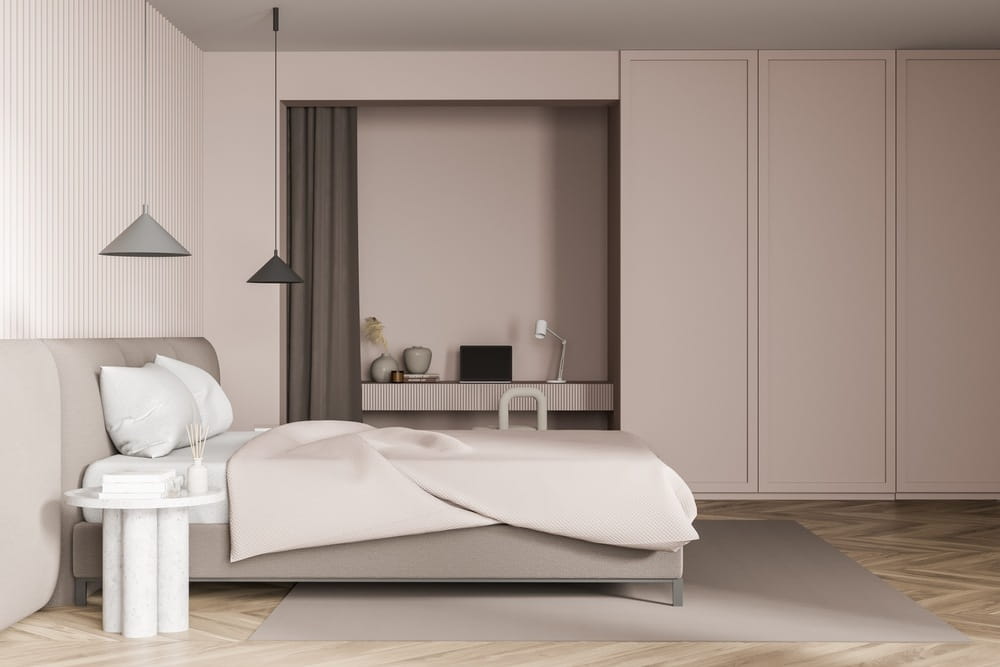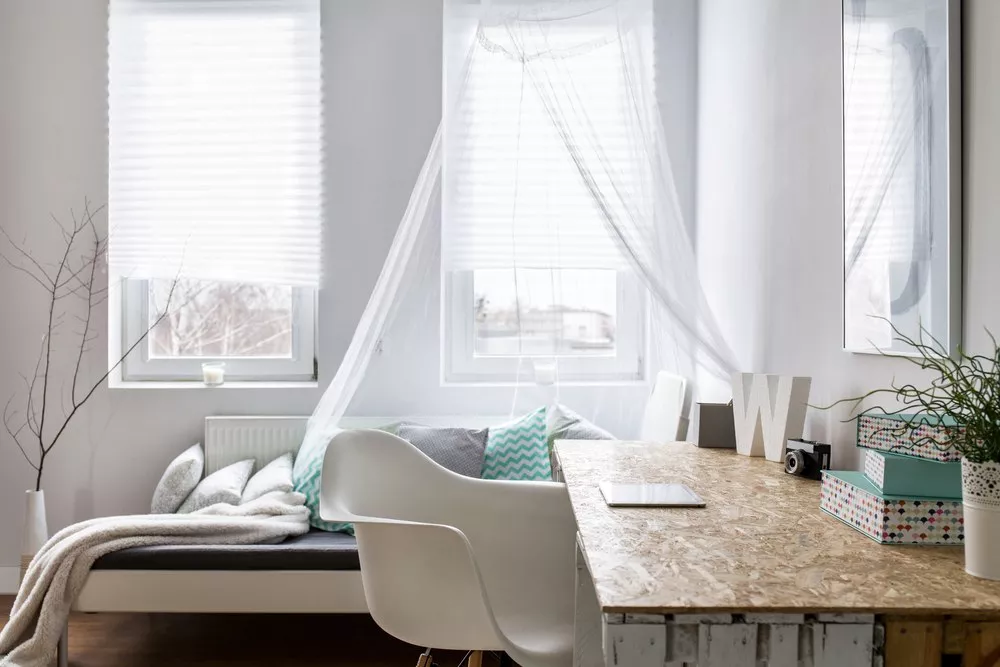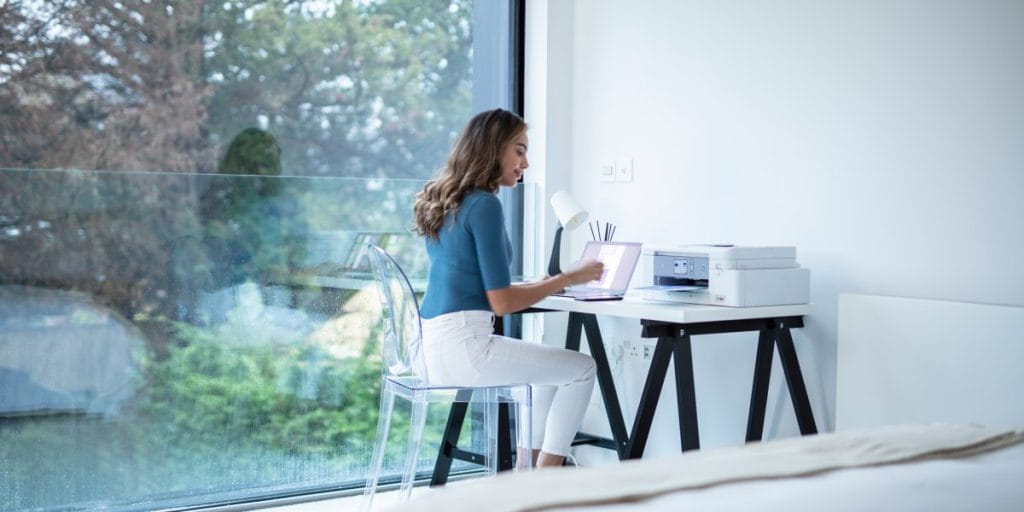What you need to know about a bedroom home office

With more of us working remotely, having a dedicated space for a home office is crucial for many Australians. Yet this in itself can be challenging if space is limited or you live in a busy household.
While many workers have gone back to the office after years of disruption, the evolving work landscape has made employers more flexible about where employees conduct their business.
This shift has resulted in workers customising their home office setups to align with their living arrangements. However, the reality is that not all workers have space for a dedicated home office and, in many cases, must get creative.
Moreover, many home-based workers have been transforming their bedrooms into office spaces, especially younger workers and those who live in share-houses or apartments. But even so, research by Brother Australia showed that most Australian workers (58%) feel their WFH set-up could be improved*.
Thankfully, there are many ways to transform your bedroom into a workspace. Read this blog to explore the pros and cons of working from your bedroom, along with helpful tips that can overcome a variety of challenges.
On this page, you'll find:
- What started the bedroom home office?
- Pros of working from your bedroom
- Cons of working from your bedroom
- 4 simple tips for working from your bedroom
- Designing your home office bedroom
- Must-have tools and equipment for home office bedrooms

What started the bedroom home office?
In the past few years, there has been a well-documented surge of Aussies working from home (WFH), and studies suggest this trend isn’t going anywhere. Recent research from UNSW Canberra found that roughly a third of employees (33%) preferred to work from home. The same study also highlighted that remote opportunities were high on many workers’ priority lists.
This comes as little to no surprise as employees reported they have become used to hybrid and remote work, according to a study commissioned by the New South Wales government.
As such, these new and evolving working conditions have ignited a new trend known as ‘work from bedroom’, or WFB for short, and it’s taking the younger generation by storm, according to sleep experts Tuck.
And it wouldn’t be a movement if it wasn’t trending on social media. #WorkFromBed has accumulated a mass following, showing pyjama-clad workers with cups of coffee working from the comfort of their bedrooms.
But is this style of work feasible? Let’s explore in detail below.
Pros of working from your bedroom
The bedroom is arguably the most important room in your house. It’s where you spend much of your time sleeping and relaxing, so it needs to be comfortable as well as practical. Whether your bedroom doubles as an office space full-time, hybrid, or on a casual basis, you’ll likely need to shuffle items and furniture around to make the space work.
Whatever the case may be, you first need to consider whether turning your bedroom into your office will suit your lifestyle. Here are some factors in favour of WFB:
- Convenience: This is probably the biggest reason people choose to turn their bedrooms into a home office. Being able to conveniently clock on to work from your bedroom would have been unthinkable many years ago
- Privacy: Unlike many other rooms in a house (living room, kitchen, etc) the bedroom is usually a private space without much foot traffic. This can make it an ideal location for doing work, especially if you need to conduct meetings over the internet, take important calls, or if your work involves confidential or sensitive matters
- Optimised for flexible work arrangements: If space is tight, then a guest bedroom or part of the living room can double as a home office. This is especially pertinent if you only WFH every now and then or in a limited capacity, such as once a week

Cons of working from your bedroom
While there are compelling reasons in favour of working from your bedroom, there are also factors that need to be taken into consideration. Let’s look at some of the disadvantages below:
- Impact on sleep: According to the Black Dog Institute, working from home can interfere with sleep, which can lead to physical and mental health problems down the track, especially for people who find it difficult to switch off from work. Some experts suggest avoiding working in your bedroom, if possible, as it will become associated with being alert, awake and switched on, complicating your sleep. The common advice is to keep computers, TVs, and work gear – materials that link mentally between the bedroom and sleep – out of the room
- Separation of work and life: There’s evidence that remote work can have a positive impact on mental wellbeing, with 97 per cent of workers attributing workplace flexibility to better health outcomes. However, some reports suggest a handful of employers expect staff to be more available at home as opposed to being in the office, although evidence is limited. So, there’s a risk that setting up a bedroom office could allow work to further intrude on your personal life, especially if you already find it hard to log off
- Sharing your private space with co-workers: Given the ease of access to remote meetings via platforms like Zoom and Teams, it helps to have a professional-looking office to set the right tone when meeting with clients or conducting important video calls
- Small available space: You may not have enough room in your bedroom to fit what you need, along with your bed, wardrobe and other essentials, to make WFH a feasible reality. Designated space may limit your ability to include essential work tools like a suitable desk, chair or printer, hindering productivity

4 simple tips for working from your bedroom
It can be challenging to get work done when your home office is also your bedroom. The temptation to take a nap or tidy up your wardrobe is strong, but with a few simple tips you can make sure that you’re productive and still get a good night’s sleep.
1. Blur your screen background
For remote meetings done from your bedroom, make sure to blur your background so that your boss, clients, or whoever you’re living with don’t know you’re working from where you sleep. While it’s a comfy place to work, a bedroom backdrop can seem unprofessional, not to mention it could become a privacy issue and an invasion of your personal space.
2. Don’t work from bed
We touched on this earlier, but physically working from bed dials things up a notch. Doing so can impact sleep quality, which hinders productivity, energy levels, and could ultimately affect your quality of life. Furthermore, if you’ve been working from your bed all day, it may make it harder to go to sleep later on as you may struggle to switch off.
3. Signal an end to your working day and create fewer distractions
Placing your laptop out of sight in a desk drawer or storing it in another room is an easy way to signal an end to your working day. Another hack here is to face your desk toward a wall or window. By working with your back to the bed, the idea is that you’ll be less likely to get distracted by thoughts of bed and sleep when you’re trying to get through your work and find it easier to sleep at night.
4. Create a space that can be packed away easily
To mitigate the potential impact on sleep and wellbeing, it’s smart to create a bedroom office that can be easily packed away, limiting the risk of work intruding into your personal life. Luckily, there are lots of clever designs that can make a bedroom office functional, like being able to be stowed under the bed, or in a drawer. It may also include using discrete recessed shelving, creating a built-in mini-office in a walk-in wardrobe, using a collapsible foldaway desk, or a hideaway cabinet for storage of your workday essentials.
Also, if you have a decent-sized wardrobe you could use it as a place to store your desk at the end of a workday. It may mean getting rid of some clothes, but on the upside, you can shut the door when you’re finished.

Designing your home office bedroom
There are a few basics you may like to consider that are all about maximising the small space of a bedroom, while retaining its character. For instance, to make the most out of the space while embracing its mixed function, try choosing multi-functional bedroom furniture. This will help ensure that your bedroom office is practical as well as being not overloaded with unnecessary items.
On the flip side, it may be the case that a bedroom’s floor plan is underutilised, allowing you to turn an unloved corner of the room or alcove into a study nook. It may be tempting to leave a corner vacant but placing an ergonomic desk and chair can transform the space into an area that’s both elegant and functional.
Another factor to consider is that a bedroom should ideally be a place of refuge, and you don’t want to ruin this with an intrusive office-style design. You can prevent bringing work stress into the bedroom via design by adding throw blankets and pillows to make the area more inviting and warmer.
It’s also an idea to use design to foster vibrancy and positivity. Neutral colour palettes, family photos and indoor plants are easy ways to add a personal touch to your bedroom. For more design ideas, check out our article on top home office trends.

Must-have tools and equipment for home office bedrooms
Workspace ergonomics should be at the top of your bedroom office checklist. More than a quarter of Aussie workers have an adjustable desk (27%), while fewer than half (46%) have an ergonomic chair.
Firstly, it’s vital to pinpoint the optimal range for your desk and chair based on your height and build. That will help you avoid physical strain and injuries like back pain.
Once you’ve found your ideal desk height, there are lots of other ideas that may assist. These include using a standing desk, a laptop riser to bring screens up to eye level, and an all-in-one printing and scanning solution – like one of Brother’s multi-function printers – to ensure you have enough space to achieve the correct body position at your desk.
Another essential for your bedroom office is good lighting. Although this seems obvious, it’s often overlooked by workers at home, even though lighting is shown to significantly impact productivity and wellbeing. A clutter-free desk and enough storage are also must-haves.
Like any office, you’re going to need good connectivity and that could mean various cables and wires. At the same time you don’t want to ruin the bedroom’s look and feel. Think about concealing power points in cabinetry or cable boxes to enable discrete charging of devices and high-speed connectivity, as well as having enough storage to keep tech accessories out of the way. Not doing so properly could lead to tripping hazards.
Like unwanted cables, clutter is another enemy in a bedroom office. If storage is an issue, an easy way to get rid of scraps of paper, notebooks, and post-it notes is to go paperless. There are many apps like Evernote, Google Keep, Bear, and numerous others that make cloud-based note-taking easy and a paperless home office a reality that’s within grasp.
At the end of the day, creating the perfect bedroom office is all about trial and error, but it can be a great way to work from home for many.
For more ideas and inspiration, read our article on how to make your WFH space work for you.
*Research conducted in May 2022 by PureProfile on behalf of Brother Australia, on a sample of over 1,000 working Australians.

Resource Library
Be the first to receive exclusive offers and the latest news on our products and services directly in your inbox




